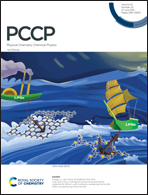A theoretical study on the electronic, structural and optical properties of armchair, zigzag and chiral silicon–germanium nanotubes
Abstract
In this work we have studied infinite size silicon–germanium alloy nanotubes of several types, armchair, zigzag and chiral, by theoretical analysis based on density functional theory as implemented in the SIESTA code, which utilizes a linear combination of atomic orbitals and a generalized gradient approximation proposed by Perdew, Burke and Ernzerhof (GGA–PBE) for the exchange and correlation energy. The structures were relaxed until the atomic forces were less than 0.0001 eV Å−1. The electronic band structure, density of states and cohesive energy were then computed; the optical calculation was run in between 0 and 6 eV, with a broadening of 0.05 eV. The obtained results exhibit the deformation of the structure on the surface, which seems to be related to its stability. The armchair and zigzag tubes are direct band gap semiconductor materials, while chiral nanotubes shift from indirect to direct bandgap semiconductors, depending on their diameter size. Likewise, the bandgap depends on the diameter of the SiGe nanotubes (SiGeNTs). We have associated the absorption curves and the density of states through Van Hove singularities. In summary, our results on the structural and electronic properties of SiGeNTs elucidate their possible applications in thermoelectrics, photovoltaics and nanoelectronics, while the possibility of associating the absorption curves with the density of states provides a method of characterization.



 Please wait while we load your content...
Please wait while we load your content...